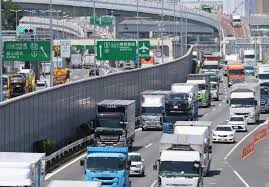To address a truck driver shortage, Japan intends to construct an automated cargo transport corridor between Tokyo and Osaka, which the government has termed a “conveyor belt road.”
The project’s funding amount is still up in the air. However, it is seen as a crucial strategy to assist the nation in managing the surge in deliveries.
Large, wheeled boxes are seen traveling over a three-lane corridor, commonly known as an “auto flow road,” in the middle of a large highway in a government computer graphics film.
To become fully operational by the mid-2030s, a trial system is scheduled to begin testing in 2027 or early 2028.
Yuri Endo, a senior deputy director in charge of the initiative at the Ministry of Land, Infrastructure, Transport, and Tourism, stated that “we need to be innovative with the way we approach roads.”
The approach will help reduce carbon emissions in addition to compensating for a declining labor force and the need to lighten drivers’ responsibilities, she said.
“The auto flow-road’s main idea is to use a 24-hour automated and unmanned transportation system to create specific areas within the road network for logistics,” Endo stated.
The concept would seem like a solution that would only be effective in densely populated, relatively low-crime civilizations like Japan, and not in large, expansive countries like the United States.
However, Switzerland and the United Kingdom are also considering similar proposals. The London design will be a completely automated system powered by inexpensive linear motors, but the Swiss plan calls for an underground pathway.
Forklifts will be used for automated loading in Japan, which will be coordinated with ports, railroads, and airports.
The boxes are roughly the size of a large closet, measuring 180 centimeters (almost six feet) in height and 110 centimeters (3.6 feet) by 110 centimeters (length and width).
If all goes according to plan, the system—which is also meant for corporate deliveries—may be extended to additional routes.
Even if driverless technology may be employed in the future, human drivers may still be required to make last-mile deliveries to people’s doors.
Laptops 1000Laws that restrict how much overtime drivers can work that went into effect earlier this year are making Japan’s truck driver shortage worse.
In Japanese logistics, government, and transportation circles, that is referred to as the “2024 problem,” even though it is considered essential to prevent overwork and accidents and to make jobs bearable.
According to government forecasts, under existing circumstances, Japan’s total transport capacity will decrease by 34% by 2030.
According to the Japan Trucking Association, trucks account for nearly all (more than 91%) of the approximately 4.3 billion metric tons of domestic transport capacity.
That is only a small portion of what is happening in a large nation like the United States.
The United States currently transports around 5.2 trillion ton-miles of freight annually, with that number expected to rise to over 8 trillion ton-miles by 2050.
The typical measurement is one ton per mile, which indicates how much freight has been shipped and how far it has been moved.
Even as the general population continues to decline due to a low birth rate, government data shows that the demand for online shopping delivery increased throughout the epidemic, with users rising from roughly 40% of Japanese households to over 60%.
The majority of job applicants find truck drivers’ demanding occupations, which require them to travel for days at a time, undesirable.
Around 1,000 people have died each year as a result of delivery trucks colliding with cars in recent years.
The Trucking Association, which represents about 400 trucking companies and organizations nationwide, would like to make deliveries even safer, even though that is an improvement over the roughly 2,000 fatalities that occurred in 2010.
Additionally, the association is advising customers to combine their products or postpone delivery orders. Businesses are being advised by some industry experts to restrict their free delivery promises.
According to Yuji Yano, a professor at Ryutsu Keizai University, which is supported by the delivery behemoth Nippon Express Co., now known as NX Holdings, and focuses on economics and liberal arts studies, including trucking issues, trucks transport roughly 90% of Japan’s cargo and 60% of the country’s fresh produce, such as fruits and vegetables, come from far-off places that require trucking.
That implies that the 2024 issue is genuinely a people’s issue rather than merely a transportation one, Yano stated.

















